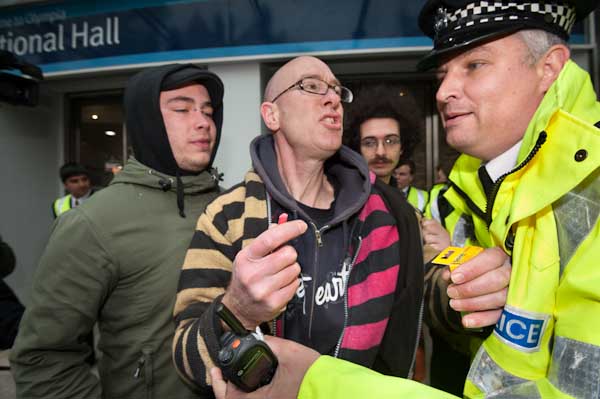On Wednesday I saw a man arrested by police for chalking on a pavement – the charge was ‘criminal damage.’ I spent years chalking on blackboards in a teaching career without ever being charged with anything more than terminal boredom. Chalk doesn’t damage boards or stone and wipes away without trace.

I have a small confession to make that might get me banned from some competitions. That stick of chalk he is holding didn’t actually look very red in my photograph. The way that my flash caught it made it a very pale pink, and it took a little bit of Lightroom magic to get it looking red in the picture.
The flash too was a little too bright on the officer’s jacket and especially its reflective strips, and that too took a little taming.
Almost all of my photographs get a certain amount of corrective work, but its aim is always to make the picture seem natural and to reflect how I saw the scene when I took the picture. I don’t want people to look at one of my pictures and think that I’ve vignetted it or altered it in some way, really I don’t want them to think at all about the techniques, just to see and respond to the image.
Of course with digital images there is a certain amount of technical information embedded in them (unless you deliberately remove it.) So the EXIF data on this frame tells me I was working at ISO 640 (it was quite a dull day) that the exposure was 1/320 f6.3, the focal length 16mm and the subject distance 400mm – about 16 inches if like me you grew up in pre-decimal days. It also tells me that the flash did fire, that I was using an exposure bias of 1/3 stop and a few other things like the exact time according to my camera.
It doesn’t – so far as I can see – tell me I was shooting with the flash set at -1 stop and was probably using it in through the lens balanced flash mode. I think the camera ignores the flash exposure and sets the aperture and shutter speed on the ambient light only, but I don’t think the manual makes this clear.
Several things strike me about this, other than the evident absurdity of the alleged offence. First is that until fairly recently the fastest synchronisation speed on any of the cameras I worked with was around 1/100th second and that using fill-flash would have involved some tricky calculations that would have made it virtually impossible for pictures like this.
The second thing is that distance of 16 inches, I think from me to the hand holding the chalk. I was certainly working fairly close, but still making sure I wasn’t impeding the officer in his duty. I’m surprised it was quite that close, but things do look a little different when you are viewing the world through a 16mm lens. But had I moved back at that point, I would soon have been trying to photograph through the back of another photographer. A few seconds later, there was a ring of police and PCSO’s surrounding the man and I had to work from further back.
You can read more about the event and see the pictures in Olympia Counter Terror Expo Exposed on My London Diary.